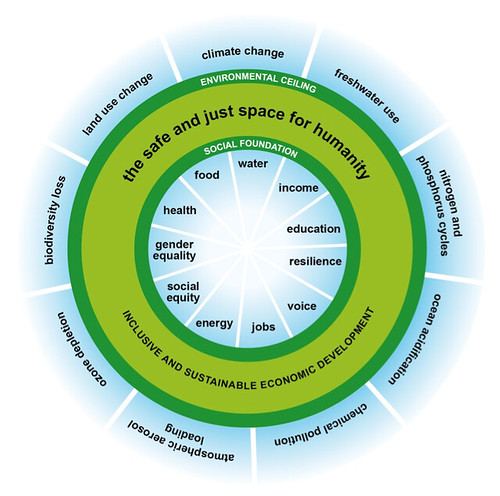Blog
Doughnut Economics- very tasty!
18th October 2012
Today I went to a fascinating and very thought-provoking lecture from Kate Raworth, a Senior Researcher for Oxfam GB. She introduced the audience to the idea of doughnut economics, and certainly convinced me about the usefulness of this very elegant and accessible development economics theory. I can't wait to share it with my classes when we're discussing sustainable development next year!
I've typed up my notes from the session below, but I would encourage everyone to watch the video of this lecture, which will shortly be available from the RSA here . Alternatively, you can download the full Oxfam discussion paper . To keep up to date with the latest on this exciting economics theory, you can follow the Doughnut Economics blog .
One of the key themes throughout the lecture was an emphasis on the idea that economic growth isn't necessarily the only statistic that governments and international organisations should be focusing their efforts on. There are other issues that need to be addressed, such as deprivation, degradation, and inequality. Inequality, in particular, has been rising drastically in many countries around the world. An excellent quote from Simon Kuznets, way back in 1934, summed up this issue nicely:
'the wealth of a nation can scarcely be inferred from a measure of it's national income'
Kate then moved on to explain the idea of 'planetary boundaries'- focusing on the environment and how, if we want the Earth to survive, there are limits which we must not go beyond on issues such as biodiversity loss and climate change. These are illustrated below, and the orange sections show how we're way over the limit on several of these key measurements.
Where Kate has taken this further is by adding an inner circle, to create the doughnut. The idea here is that we should also be focusing on the 'social foundation' that is crucial to creating 'a safe and just space for humanity'. We are aiming, therefore, to be somewhere within the 'edible' part of a doughnut- beyond the social foundation level but below the environmental ceiling. This is clearly shown below:
Having illustrated the problem, Kate suggested examples of why this should not be considered an insurmountable challenge. For example, we would need only 3% of the world's current food supply to end hunger for everyone and electricity for all could be achieved with only a 1% rise in CO2 emissions.
Our planet is suffering under pressure from the 'carbonistas' in the West- with 50% of C02 emissions coming from just 11% of people and 33% of the global nitrogen budget used up in producing meat for the EU market.
In conclusion, Kate used these statistics and the doughnut economics argument to clearly demonstrate that environmental protection and economic development can co-exist quite happily. We need a wider understanding of development than just a narrow focus on GDP growth if we are to ensure a safe and prosperous future for our planet and it's inhabitants.
(N.B. These are my own notes from the lecture, so any mistakes are mine)
You might also like
Economic Growth Revision Quiz
Quizzes & Activities

Sustainable Development Goals - Decent Work
29th September 2015

Beyond the Bike - Lesson Resource on Chinese FDI into Zambia
27th November 2015

Cloud Fishing in Morocco
28th December 2016
Sub Saharan Africa Development Report 2018
Study Notes
Asia sees first regional economic recession in sixty years
15th September 2020

Why market structure matters for development
3rd August 2021


